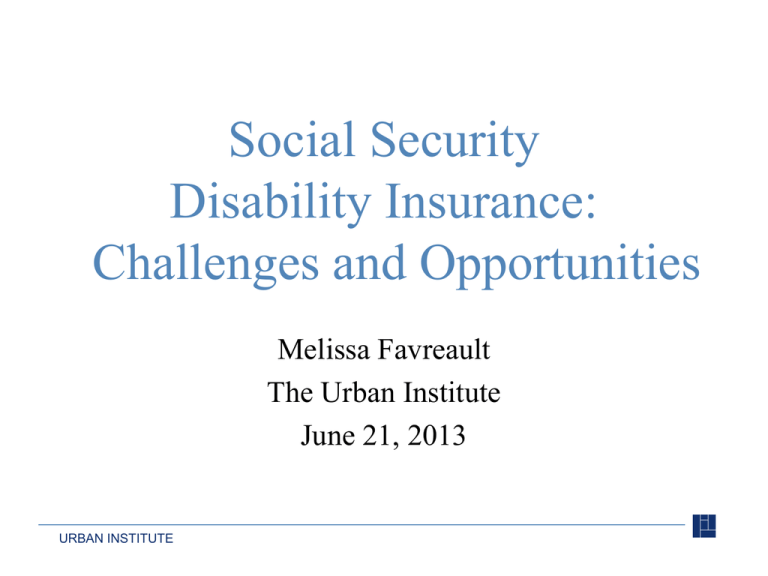Social Security Disability Insurance: Challenges and Opportunities Melissa Favreault
advertisement

Social Security Disability Insurance: Challenges and Opportunities Melissa Favreault The Urban Institute June 21, 2013 URBAN INSTITUTE Goals • DI beneficiaries’ characteristics – – – – – Demographics/health/mortality Replacement rates Poverty and near poverty status, hardships Percentages in each income quintile Income composition/share from DI • Implications for Social Security discussions – Solvency packages and parameters, including parameters specific to DI URBAN INSTITUTE DI beneficiaries are older, have less education than nonbeneficiaries URBAN INSTITUTE DI beneficiaries report health problems and die at high rates URBAN INSTITUTE DI beneficiaries have diverse experiences and needs • Onset age • Type and severity of impairment – Multiple impairments / interacting impairments – Sudden (e.g., traumatic injury) or slow onset – Rapid mortality or long-duration receipt • Education, work history, and experience • Social Security / SSI beneficiary status – Some (mostly women) will convert to survivor or spouse benefits later in life URBAN INSTITUTE DI replaces less than half of predisability earnings for most beneficiaries URBAN INSTITUTE Nearly half of DI beneficiaries receive at least half of their income from DI (much higher for unmarried) URBAN INSTITUTE DI beneficiaries, especially when young, are concentrated in lower quintiles of income distribution URBAN INSTITUTE Many DI beneficiaries, especially the unmarried, are poor or near poor URBAN INSTITUTE Discussions of Social Security finances need to consider DI URBAN INSTITUTE Payroll tax re-allocation has precedent URBAN INSTITUTE DI beneficiary poverty and near poverty would increase markedly with “payable” (or “feasible”) benefit reductions URBAN INSTITUTE Options to improve Social Security’s long-range finances • Increase revenues – Increase payroll tax rates – Increase earnings base to which the rates apply • Taxable maximum ($113,700) • Other forms of compensation – Increase revenue from taxation of benefits • Reduce benefits • Some combination – Other options (e.g., invest Trust Fund) entail risk URBAN INSTITUTE Critical features of Social Security solvency plans • Split between revenues and benefits – Relatively modest shifts can have large distributional impacts • Time path/cross-generational effects – Adjustment time vs. sharing burdens – “Sustainable solvency” (75th year issue) • Within-cohort distributional effects – Focus on DI, but other important effects include lifetime earnings, gender, marital status, work URBAN INSTITUTE The usual suspects: Parameters in solvency packages Revenue side: • Taxmax: Uncap / cover 90% of earnings ($239,400) / impose surtax over a limit (e.g., $250,000) • Payroll tax Benefit side: • • • • Shift COLA to chained CPI FRA/EEA increases or indexing Progressive price indexing Upper bend point reduction without index URBAN INSTITUTE Parameters that focus on DI (CBO and CRS reports, legislations, plans) • 5-month waiting period • Integration with EEA / FRA – DI beneficiaries starting at age 62 receive 100% of PIA – Age 62 OAI claimants receive 70/75% of PIA — Voluntary vs. involuntary withdrawal due to disability – Actuarial fairness may justify a difference – Medicare access crucial consideration • Insured status requirements – Require 4 of last 6 years rather than 5 of last 10 • Shift from AWI to median wage (Muller 2008, SSB) URBAN INSTITUTE Parameters that focus on DI (CBO and CRS reports, legislations, plans) • Process changes may have special promise – Speed up / modify determination • Complexity of process • Use of scoring / data to streamline decisions / process • Reconsideration / Administrative Law Judges – Early intervention • Accommodation • Workforce development, expanded EITC • Up-front investment could lead to savings later – Continuing Disability Reviews URBAN INSTITUTE Solvency parameters that don’t target DI but affect DI beneficiaries/subgroups differentially • Comparatively deep effects: COLA changes (if longterm beneficiary), personal account approaches (truncated accruals compromise adequacy) • Comparatively less deep effects: Taxable maximum, high bracket reductions, taxation of benefits • No effects: FRA increases – But NOT if specified as PIA reductions • Adjustments to improve adequacy, offset reductions URBAN INSTITUTE Package components differ from packages’ overall effects • A package that carefully considers DI beneficiaries’ needs will not necessarily be comprised entirely of elements that hold DI beneficiaries harmless. • Implications for solvency discussions: offsets and adjustments elsewhere. • Earlier action leaves more options and gives taxpayers, beneficiaries, and future generations more time to adjust. URBAN INSTITUTE Social safety net as a whole: Social Security’s programmatic context • Health assistance programs often support workers with disabilities. – Medicare, Medicaid, ACA coverage expansions. – Flexibility for dealing with OASDI will depend on health care cost growth. • Disability assistance programs. – Gina will speak about work supports. • Program interactions – SSI, SNAP, UI, Workers’ Compensation. URBAN INSTITUTE Social and economic context • Parallel trends in key indicators: concentration of gains at high earnings/education levels. – Mortality – Health status – Earnings gains (very high percentiles) • Making policy in this context: How about indexing for inequality? – Payroll/income tax side – Benefit side (multidimensional inequality: even marriage) • Shared prosperity / inclusion may require investment URBAN INSTITUTE Conclusions • Many DI beneficiaries—especially those who are younger, unmarried, and whose disabilities onset early—are economically vulnerable. – A lot of opportunity to do better. • Poses tremendous challenges for placing the Social Security system on 75-year footing. – Implications for the revenue-reduction mix, and distributional tilt, especially on benefit side. URBAN INSTITUTE Acknowledgements We are grateful to the Ford Foundation for support of this event and our work. All views are my own and not those of the Urban Institute, its board, or sponsors. Please visit us at: www.urban.org and www.retirementpolicy.org URBAN INSTITUTE Appendix: Data • Primarily from the Survey of Income and Program Participation (SIPP) matched to administrative records / MINT • Age-specific comparisons (sample is ages 31-64) • Estimates sensitive to a range of choices – How to treat families (especially complex families), assets/asset income, rounding rules – Ever DI compared to now on DI • Relative differences typically robust to these choices, but point estimates change URBAN INSTITUTE



